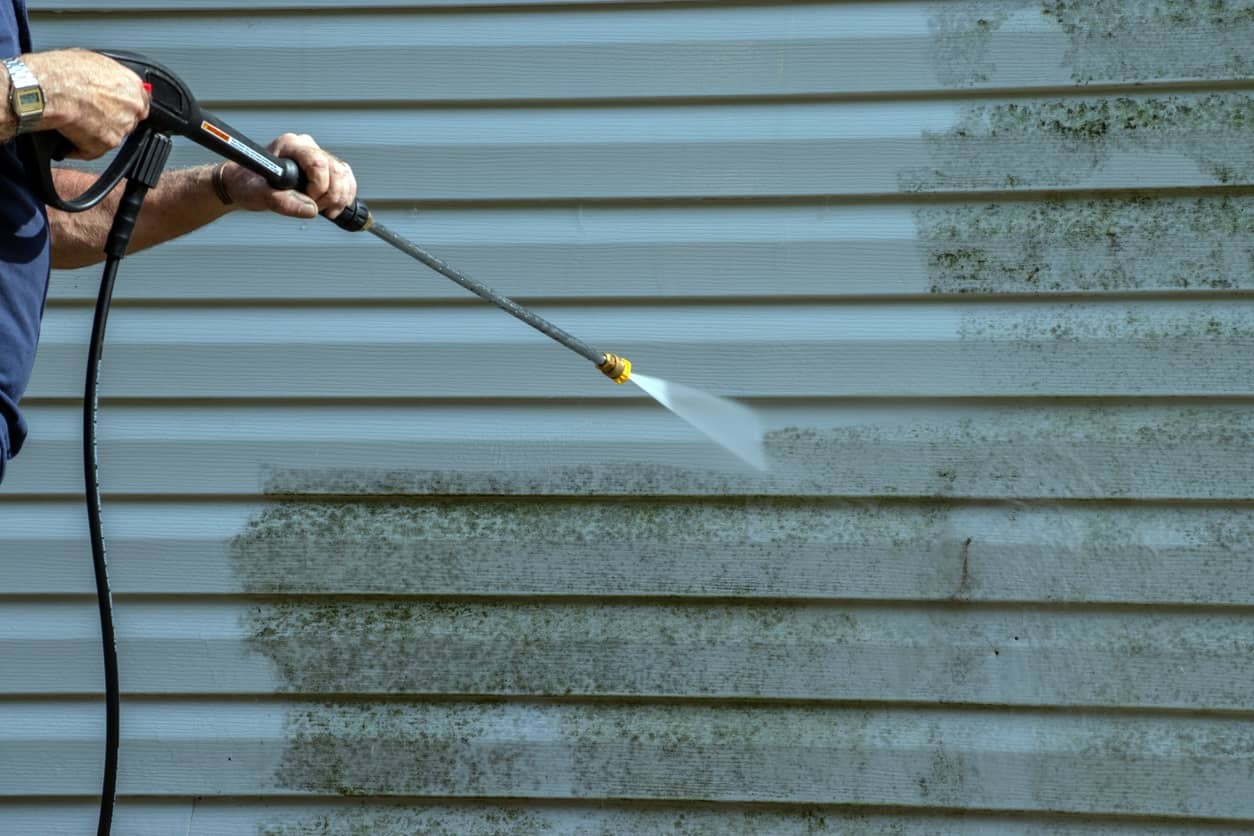If your vinyl siding is faded, chalky, or stuck in the wrong decade, you might be wondering if paint is a realistic option—or a recipe for peeling and regret. The short answer: Yes, you can paint vinyl siding, but only if the surface is sound and you’re using the right products and techniques.
This guide cuts through the confusion. We’ll cover when painting is a smart move, what kind of paint to use, how to prep correctly, and why hiring a pro might save you money in the long run.
WHY HOMEOWNERS CONSIDER PAINTING VINYL SIDING
Vinyl siding is known for its durability and low maintenance, but even the best materials don’t last forever. After years of UV exposure, your once-bright exterior may look washed out or yellowed. That doesn’t necessarily mean it’s time for replacement—painting is a viable, cost-effective alternative if the siding is still structurally sound.
Here are some common reasons homeowners consider painting vinyl siding:
-
Aging and fading: UV exposure breaks down the pigments and surface coating over time.
-
Cost of replacement: Replacing vinyl siding can cost three to five times as much as a professional paint job.
-
Curb appeal: Some colors that were popular in the ‘80s or ‘90s don’t match today’s design preferences.
-
Color change without full replacement: Painting lets you update the aesthetic of your home without tearing off what’s still structurally functional.
Homeowners often ask: “Will the paint actually stick?” The answer is yes—with the right prep and the correct vinyl-safe products. Paint adheres well to vinyl when cleaned properly and coated under the right conditions. Color selection also matters (we’ll cover that below), as going too dark can cause warping due to heat absorption.
PROS AND CONS OF PAINTING VINYL SIDING
Painting vinyl siding comes with real advantages, but it’s not without its drawbacks. Understanding both sides helps you make an informed choice.
BENEFITS:
-
Cost savings: Painting usually costs between $3,000 and $5,000, compared to $10,000–$20,000 to replace vinyl siding.
-
Sustainability: Extends the life of existing siding and reduces landfill waste.
-
Customization: Paint allows more freedom with color, especially with vinyl-safe color lines from trusted brands.
-
Curb appeal: A modern color can dramatically refresh your home’s exterior, especially for resale.
DRAWBACKS:
-
Not a permanent solution: Painted siding typically lasts 8–10 years, while new vinyl can last 30+.
-
Color limitations: Choosing a much darker color than the original can cause warping due to increased heat absorption.
-
Prep sensitivity: Cleaning, drying, and product selection must be precise—cut corners and you risk peeling or fading.
-
Warranty issues: Some siding manufacturers void warranties if painted, especially in unapproved colors or without proper prep.
Here’s a quick side-by-side:
| Factor | Paint Vinyl Siding | Replace Vinyl Siding |
|---|---|---|
| Average Cost | $3,000–$5,000 | $10,000–$20,000 |
| Lifespan (well-executed) | 8–10 years | 20–40 years |
| Warranty Risk | Possibly voided | Manufacturer-covered |
| Environmental Impact | Low (reuse siding) | High (material disposal) |
| Color Customization | High (within limits) | High |
Bottom line: Painting makes sense when your siding still has structural life but just needs a cosmetic refresh.
WHEN PAINTING VINYL SIDING IS (AND ISN’T) A GOOD IDEA
Painting makes sense if:
-
Your siding is in good structural condition—no major cracks, warping, or moisture damage.
-
You’re looking for a cost-effective refresh and plan to stay in your home another 5–10 years.
-
You want to modernize the look without investing in full replacement.
Avoid painting if:
-
The siding is brittle, cracked, or bowing.
-
There’s mold, rot, or signs of water infiltration beneath the panels.
-
You want to dramatically darken the color from the original siding (especially in high-sun areas).
-
The manufacturer warranty specifically prohibits painting.
Color regret is real. Many homeowners worry about making the wrong choice and being stuck with it. That’s why professional painters offer sample boards and digital color previews to help visualize the final result in different lighting conditions.
Also important: Check with your HOA or local regulations. Some communities have color restrictions or require approval for exterior changes.
CHOOSING THE RIGHT PAINT AND COLOR FOR VINYL SIDING
Not all paints are safe for vinyl. You need products specifically formulated for plastic-based exteriors. The wrong paint can flake, bubble, or cause heat damage.
Recommended Paint Types:
-
100% acrylic latex – Flexible, breathable, and adheres well to vinyl.
-
Vinyl-safe lines – Sherwin-Williams VinylSafe®, Benjamin Moore Regal Select are top picks. These are engineered to expand and contract with vinyl.
-
No oil-based paint – These can become brittle over time and don’t flex with temperature changes.
Color Selection Tips:
-
Stick to similar or lighter shades than the original color. Going too dark increases the chance of heat-related warping.
-
Check the Light Reflectance Value (LRV)—aim for 55 or higher to ensure heat isn’t absorbed excessively.
-
Mid-tone neutrals and soft grays, beiges, and blues tend to be vinyl-safe and timeless.
Color-Specific Concerns:
-
If you’re unsure how a color will look in sunlight or shade, sample patches are a smart step.
-
Professionals can also provide siding-specific color advice based on your brand of siding and regional climate.
When in doubt, a paint contractor experienced with vinyl siding will help ensure color safety and avoid costly warping or warranty issues.
HOW TO PREP VINYL SIDING FOR PAINTING
Prep is everything. If the surface isn’t properly cleaned and dried, paint won’t stick—and you’ll see peeling in a matter of months.
1. Inspect the Siding
-
Look for cracks, warping, or any areas where panels are loose or damaged.
-
Check for signs of moisture, mold, or rot.
-
Replace or repair these issues before any painting begins.
2. Clean Thoroughly
Vinyl attracts dust, mildew, and chalky residue. All must be removed for paint to adhere.
-
Use a soft pressure wash or manual scrub with water, dish soap, and white vinegar.
-
Avoid overly harsh cleaners or pressure, which can etch or damage the surface.
-
Rinse well and let dry for 48 hours minimum.
3. Light Sanding (Optional)
-
If your siding is glossy or particularly smooth, lightly sand to create a better surface for paint to grip.
-
Focus on high-gloss areas or any patches repaired with filler.
4. Mask and Protect
-
Cover windows, trim, doors, landscaping, and walkways.
-
Use painter’s tape to get sharp lines along trims and edges.
Pro Tip: Many homeowners underestimate the importance of proper drying and surface prep. Professionals use siding-safe cleaners, moisture meters, and high-grade masking materials to avoid sloppy results.
HOW TO PAINT VINYL SIDING PROPERLY
Once your surface is clean and dry, application makes all the difference in durability and appearance.
1. Primer—Only When Necessary
-
Most modern vinyl-safe paints don’t require a primer unless you’re covering patch repairs or exposed substrate.
-
If needed, use a bonding primer rated for plastic surfaces.
2. Paint in Optimal Conditions
-
Ideal temperature: 50°F to 85°F
-
Avoid direct sun, wind, or rain within 24 hours
-
Humidity should be moderate—avoid painting during high-moisture days
3. Apply Paint Correctly
-
Use an airless sprayer for smooth, even coverage.
-
Back-roll for better adhesion and texture control, especially on older siding.
-
Apply two thin coats—thick layers increase the chance of runs and peeling.
4. Final Inspection and Touch-Ups
-
Look for missed edges, lap marks, or overspray.
-
Use a fine brush for detailing around fixtures and trim.
Professional Benefit: Painters know how environmental factors like humidity, sunlight, and wind affect dry times. They also apply coatings uniformly and know how to avoid overspray and uneven coverage.
LONG-TERM MAINTENANCE OF PAINTED VINYL SIDING
![]()
Painted vinyl siding can last 8 to 10 years if well maintained. Here’s how to keep it looking fresh:
-
Wash annually with mild soap and water—skip the pressure washer
-
Trim shrubs and trees to avoid scratching or moisture build-up
-
Inspect for chips or fading every year—address touch-ups quickly
-
Avoid leaning tools, ladders, or grills against the siding
Vinyl won’t “breathe” like wood, so the paint must remain intact to prevent UV and moisture damage underneath. If it begins to flake, early intervention can save thousands in rework.
WHY PROFESSIONAL HELP MATTERS
Painting vinyl siding isn’t just about color—it’s about chemistry, climate, and compatibility. Professionals understand:
-
Which products work on different types of siding
-
How weather conditions affect adhesion and drying
-
Color rules that prevent heat distortion
-
Safe techniques that avoid overspray and lap marks
They also have the tools—like commercial sprayers, ladders, masking equipment, and moisture meters—to get it right the first time.
Warranties matter too. Many painting companies offer 3–10 year guarantees on vinyl paint jobs, giving you peace of mind.
If you’re unsure whether your siding is a good candidate for paint, or which products are safe to use, a consultation with a trusted pro is the best first step.
CONCLUSION
Yes—you can paint vinyl siding. And when done correctly, it can be a smart, stylish, and budget-friendly alternative to replacement.
Just remember:
-
The surface must be clean, dry, and damage-free
-
Paint must be 100% acrylic and vinyl-safe
-
Dark colors may cause heat distortion—choose wisely
-
Prep and application determine long-term success
DIY is possible—but mistakes are costly and often irreversible. That’s why many homeowners choose professional painting teams who understand the risks and know how to deliver lasting results.
Thinking about painting your vinyl siding house? We’d love to help you plan it right. Schedule a free consultation today and get expert advice tailored to your home’s condition, siding type, and color goals.



